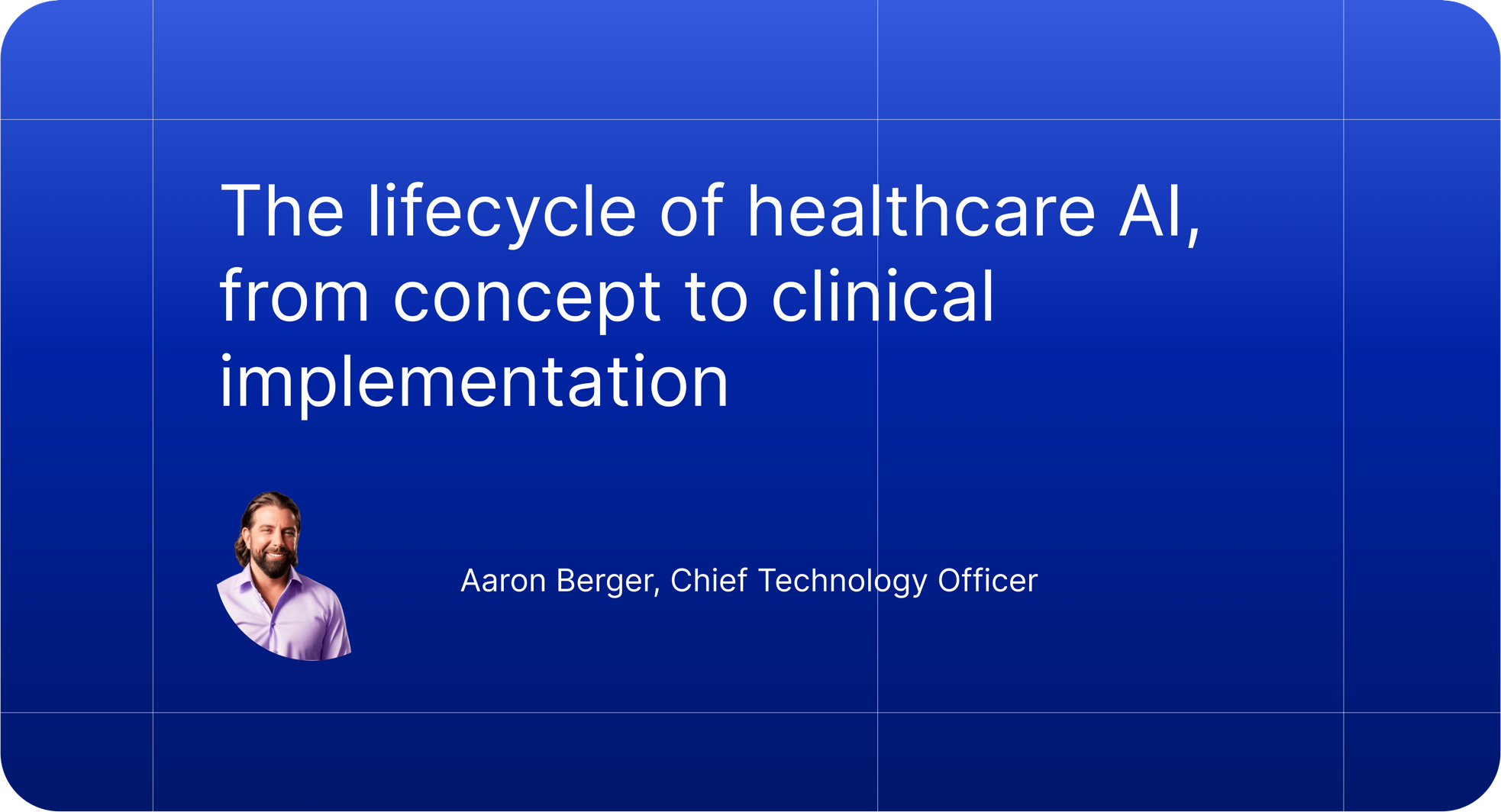Introduction to healthcare AI lifecycle
Artificial Intelligence (AI) is transforming healthcare at an unprecedented pace. From predictive analytics that forecast hospital readmissions to deep‑learning algorithms that detect abnormalities in radiology images, AI promises more accurate diagnoses, personalized treatments, and streamlined operations. Turning a healthcare AI concept into a reliable clinical asset requires a structured, repeatable process called the healthcare AI lifecycle. In this blog, we’ll dissect each stage of that lifecycle—data sourcing, model development, validation, integration, and maintenance—to provide a roadmap for taking AI from theory to the bedside.
1. Data acquisition and governance
Securing high‑quality clinical data begins with identifying sources such as electronic health records (EHRs), Picture Archiving and Communication Systems (PACS), laboratory information systems, patient registries, wearable devices, and genomics databases. Gaining access to these data repositories involves navigating Institutional Review Boards (IRBs), establishing data‑use agreements, and complying with privacy regulations like HIPAA in the United States or GDPR in the European Union. At the same time, it’s essential to conduct a bias assessment to ensure the dataset accurately represents diverse demographic groups and clinical practices, thereby avoiding the risk of perpetuating existing health disparities.
Establishing a strong governance framework is equally critical. Organizations should maintain a detailed data catalog that inventories available data assets, formats, and respective access controls. Privacy and security measures—such as de‑identification, encryption, and role‑based permissions—must be rigorously enforced to safeguard patient information. Meanwhile, ethics oversight, provided by dedicated committees or AI governance boards, ensures that project protocols align with institutional policies and uphold patient rights and consent requirements.
2. Data preprocessing and feature engineering
Raw clinical data often requires extensive cleaning and normalization before it can be fed into healthcare AI models. Missing data must be handled thoughtfully, using clinically appropriate imputation techniques such as mean substitution, temporal interpolation, or statistical model-based methods. Laboratory measurements and vital signs, which may originate from different systems or units, need to be standardized to a common scale. Free‑text clinical notes should undergo natural language processing (NLP) to extract structured data elements like diagnoses, medications, and temporal markers, transforming unstructured narratives into analyzable formats.
Annotation and labeling are fundamental for supervised learning tasks. Expert clinicians—radiologists for imaging studies or pathologists for histology slides—must provide ground‑truth labels. Employing multiple annotators and consensus adjudication helps improve label accuracy and consistency, which are vital for downstream model performance.
Feature engineering bridges clinical insight and algorithmic power. Practitioners craft domain‑driven features such as vital‑sign trend slopes, composite risk scores, or derived indices (for example, CHA₂DS₂‑VASc for stroke risk). To manage high‑dimensional data, techniques like principal component analysis (PCA) or autoencoders can reduce complexity while preserving essential information.
3. Model development and internal validation
Choosing the right healthcare AI algorithm depends on the nature of the task and data. For problems requiring interpretability and a modest number of features, simple models such as logistic regression or decision trees often suffice. When tabular data exhibit complex interactions, ensemble methods like random forests or gradient-boosting machines can capture non-linear relationships. For unstructured inputs—images, waveforms, or textual records—deep learning architectures including convolutional neural networks (CNNs) and transformer-based models offer state-of-the-art performance.
During training, techniques such as k‑fold cross‑validation help optimize hyperparameters, prevent overfitting, and provide robust estimates of model performance. Regularization methods (L1/L2 penalties) and dropout layers in neural networks further guard against overfitting. Early stopping, based on monitoring validation set loss, ensures that training halts when performance improvements plateau or deteriorate.
Performance metrics must align with clinical objectives. For classification tasks, metrics include area under the receiver operating characteristic curve (AUROC), precision‑recall curves, sensitivity, and specificity. Regression tasks rely on measures like mean absolute error (MAE), root mean squared error (RMSE), and R². Calibration assessments—such as Brier scores and calibration plots—determine how closely predicted probabilities reflect actual outcome frequencies, guiding the selection of decision thresholds appropriate for clinical action.
4. External validation and generalizability
Models validated solely on internal data risk poor performance when applied to different patient populations or healthcare settings. External validation involves testing the model on independent cohorts collected from separate institutions or geographic regions. Additionally, temporal validation—evaluating data from later periods—helps detect performance degradation over time.
Robustness checks further enhance confidence in generalizability. Subgroup analyses verify consistent behavior across age groups, genders, ethnicities, and comorbidity profiles. Stress testing simulates scenarios with missing data or atypical clinical presentations to uncover potential weaknesses before deployment.
5. Integration into clinical workflows
Technical deployment of healthcare AI models relies on interoperability standards such as HL7 FHIR for structured data exchange and DICOM for imaging modalities. SMART on FHIR enables seamless app integration within existing EHR interfaces. Infrastructure choices—whether cloud-based inference platforms for scalability or on‑premises servers for low latency and heightened security—depend on organizational priorities around cost, performance, and regulatory constraints. Containerization technologies like Docker, orchestrated via Kubernetes, ensure continuous availability and fault tolerance.
Human factors engineering and user‑centered design are crucial to adoption. Early workflow mapping identifies natural insertion points for AI‑driven insights, such as during order entry, nursing handoffs, or multidisciplinary rounds. Interface simplicity—presenting risk scores alongside confidence intervals and the top contributing clinical factors—helps clinicians interpret results quickly. Training programs, quick‑start guides, and open feedback channels foster clinician engagement and surface opportunities for iterative UI improvements.
6. Monitoring, maintenance, and continuous improvement
Post‑deployment monitoring tracks real‑world performance by comparing live data distributions and model predictions against training-era benchmarks. Drift detection algorithms alert teams to shifts in input features or outcome rates, and automated notifications can flag significant declines in accuracy, calibration, or processing throughput.
Model updating strategies vary from scheduled retraining on newly accrued data to online learning approaches that incrementally adjust model parameters. Rigorous version control tags each model release, documents parameter changes, and maintains rollback procedures for rapid mitigation if issues arise.
A robust quality management system logs inference inputs, outputs, and clinician interactions, creating an audit trail that supports compliance audits and incident investigations. Periodic governance reviews by healthcare AI oversight committees assess ongoing safety, efficacy, and ethical adherence.
7. Regulatory and ethical considerations
Healthcare AI often falls under medical device regulations when intended for diagnostic or therapeutic decision support. Organizations must prepare detailed submissions to regulatory bodies such as the U.S. Food and Drug Administration under its Software as a Medical Device (SaMD) framework or the European Union’s Medical Devices Regulation (MDR). Transparency and explainability practices—employing tools like SHAP values, LIME, or saliency maps—help clarify model reasoning for both regulators and end‑users. Finally, patient consent processes should explicitly mention AI‑driven elements when care decisions are influenced by algorithmic outputs, ensuring respect for patient autonomy and trust.
Conclusion
The path from concept to clinic for healthcare AI is complex but achievable with a disciplined lifecycle framework. By meticulously addressing data governance, model building, rigorous validation, seamless integration, and vigilant post‑deployment oversight, multidisciplinary teams can deliver healthcare AI solutions that genuinely enhance patient care. When data scientists, clinicians, engineers, ethicists, and patients collaborate throughout every stage, AI’s promise—to improve diagnostic accuracy, personalize therapy, reduce costs, and ultimately save lives—becomes a reality in the data‑driven era of modern medicine.

